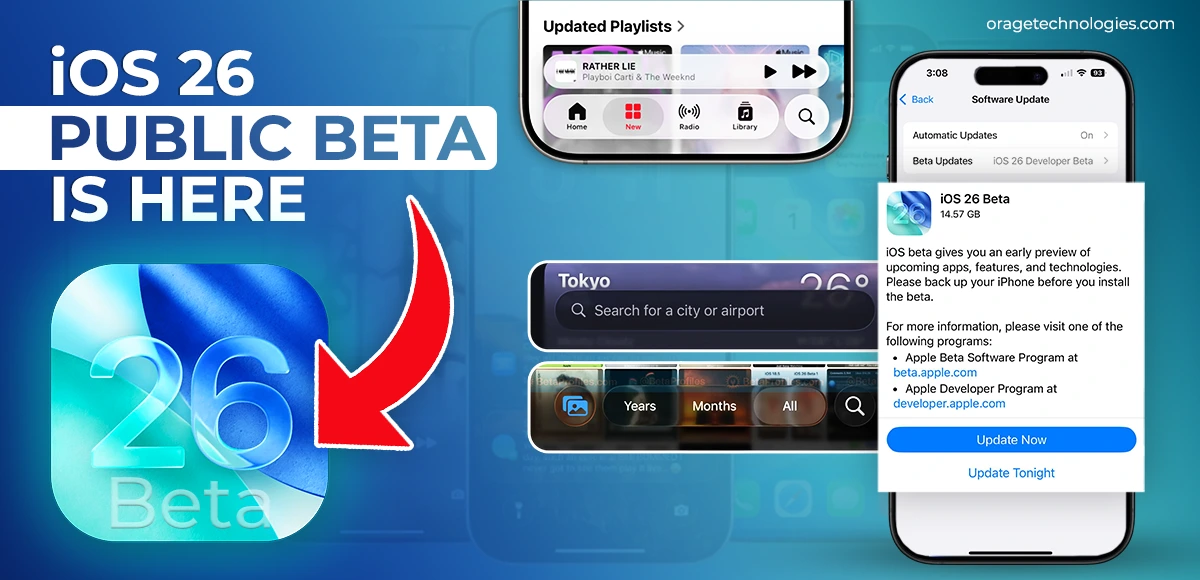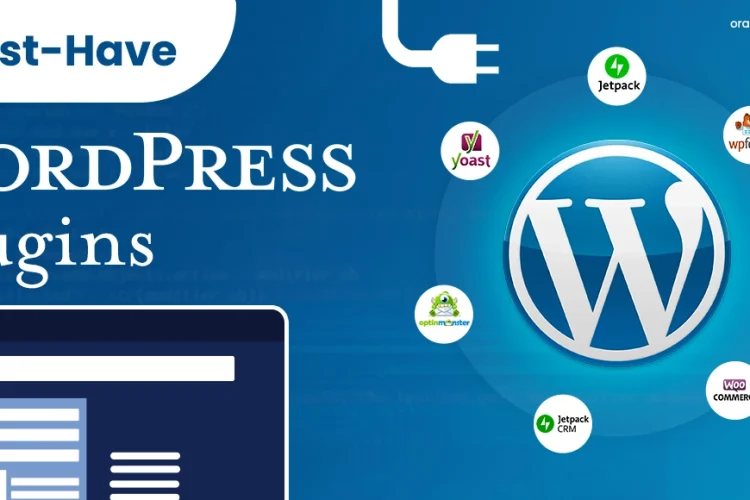
Divya Stuti, with over 5 years of experience in Digital Marketing & Content Writing, has a knack for turning complex Marketing strategies, trends, and jargon...
The next generation of iOS has arrived with its official iOS 26 public beta appearance. And it already is creating buzz with Apple being revolutionary in its design, smoother system interactions, and a few sprinkles of features that are truly helpful in using your phone day-to-day. It will not provide the long-desired AI-enhanced Siri just yet, the Apple iOS 26 shows that Apple has not forgotten how to reinvent the wheel without making a great difference in the user journey.
Let’s look at the changes and improvements that are leading to iOS 26 being one of the most ambitious releases initiated by Apple.
The Revolution Liquid Glass
The most remarkable one is the addition of a new Apple iOS 26 design language, the concept known as Liquid Glass.
This UI makeover reduces buttons, sliders, and application folders to semi-translucent moving surfaces. This looks like ripples in a pool of water. It is the next step in Apple design and is coherent at all levels, iPhone, iPad, and Mac. It makes things seem fluid and interactive. When you swipe or tap through elements, they now reflect or distort light and content beneath them.
Content is now overlapped with menus and controls that are no longer locked into fixed bars. Moreover, developers may exploit this new design as long as they supported the tinted themes on previous iOS versions. Customisable choices exist as well as obvious themes with transparent effects that will turn app icons into ghosts.
On one hand, they are very aesthetically pleasing. On the other hand, readability is occasionally sacrificed. Having said this, it appears Apple is refining the balance between style and usability in the light of preliminary feedback to iOS 26 public beta.
Refined Interactions
Apple has re-designed basic interactions in addition to the appearances. Menus of extreme lengths, filled with scrolls, are substituted by dual-stage popovers. The Tap-and-hold pops up typical choices, and taps one on an arrow. And you have a fuller list of commands for that, and all is cleaner and easier to choose.
The system gestures are also developing. Swiping to go back now works from anywhere on the screen. Not just the left edge, which improves discoverability.
Lock Screen Updates
There is a redesign of the lock screen to align with Liquid Glass.
- An active clock that changes in both size and location based on your background.
- The placement of widgets has also been changed. So now they can be dragged to the bottom of the screen, right above the notifications. This makes them easily accessible by taps.
- Spatial Scenes in the Vision Pro come in and will bring depth to your photographs according to motion.
- As of Apple Music+, album artwork is now displayed in animation on a lock screen when music is played through that service or a third-party app.
On the one hand, certain elements, such as the rainbow-colored clock, are pushed aside. But, on the other hand, most of the changes make personalisation even more significant.
Camera and Photos: less complicated and intelligent
It provides a redesign of a usability-first Camera app.
- The default interface has only the most popular modes, such as Photo and Video.
- Swipe Right or Left, and you can get Panorama, Portrait, Slo-mo, etc.
- More complex controls (aperture, exposure, etc.) are hidden but nevertheless accessible.
- It is now possible to snap pics or activate video records with AirPods.
- Photos app returns to the tabbed view, and Visual Intelligence can now recognise events such as concerts.
- Moreover, it can add information such as setlists, venues and artist links.
The Reimagined Phone App
Phone calls are not dead. Apple redesigns the Phone application heavily:
- Unified View: You can add favourites, recents, missed calls and voicemails in a long list.
- Spam Filtering: A new “Spam” section is included, and you can block or report contact related to spam calls.
- Screen Unknown Callers: Employs the use of AI to recognise the need to ask the caller to introduce themselves before the phone can ring.
- Hold Assist: It can discriminate between hold music and a human voice picking up. However, it remains in training.
Minimalist Safari with a Twist
A close redesign of Safari is noticed:
- The UI is simplified to a location bar, a back button and a More menu.
- Certain functions (such as sharing) are repeated in various locations.
- It does not prohibit you from switching back to the classic Safari layouts.
- Support of web extensions is enhanced under the hood, and every website can now be saved as a full-screen web app.
Visual intelligence: past the camera
Its range is increased by AI-based Visual Intelligence:
- Is now able to deal with screenshots instead of only with photos.
- Ask, a ChatGPT-powered option, and Google-powered Image search are seen as soon as a screenshot is taken.
- You may title the definite areas of the picture to search or analyse.
- Instead, AI recognizes useful information, such as URLs or calendar events and provides instant actions.
- It is an incredible growth that transforms screenshotting into a research tool and not only a memory tool.
Minor Apple iOS 26 Features:
Apart from major redesigning and feature addition, there are many other improvements. These may look small, but they are very effective when it comes to functionality. Let’s have a look at them:
- Battery settings: A new graph illustrates the use of the battery compared to daily averages. Adaptive Power mode is designed to conserve power when you are under heavy phone usage.
- Local Audio Recording: Now it is possible to record podcasts with external mics or AirPods as a voice note.
- Notes Export to Markdown: It is useful to other web writers or web developers.
- Passwords App: Follows the password alterations and the history of generation.
- AutoMix in Music: changed like the DJ to create fewer bumps in sequence.
- Maps: Find your visited places by city or category, and it is all saved safely on your device.
- Adjustable Snooze Time: It is a long-overdue feature among Clock app users.
- Messages: Lastly, it is possible to select a subpart of a text bubble, not the entire one.
CarPlay Enhancements
There is love being served to CarPlay, too:
- Liquid Glass UI
- Lower statuses of incoming calls
- Messages tapbacks mess
- Widget support (But usages rely on the screen size and relevance)
Apple Intelligence in Apple iOS 26
Although the major Siri update has been delayed, Apple introduced minor features of AI throughout the system:
- Image Playground ChatGPT
- Genmoji (use emojis together to make new emojis)
- Our voicenote and notifications are summarized.
It is all about low-key brilliant capabilities instead of shiny new sidekicks.
Should You Try the iOS 26 public beta?
When you love living on the bleeding edge, iOS 26 public beta is surprisingly robust and complete in features. The majority of features announced at WWDC are available now, and there are only a few still absent.
Nonetheless, unless you are into the bugs and crashes scene, you should wait until the release in autumn. And at this early stage- iOS 26 public beta, it is far less of a revolution and far more of a smart reimagining. It is a well-integrated, cross-platform update where the practical benefits are applied daily. As the new line of products in the mobile computing industry with the design philosophy of both fluid beauty and functional minimalism, iOS 26 takes a pattern of the future of Apple in mobile computing.
Therefore, regardless of whether you want to take screenshots to spend more intelligently, robocall your unwanted calls into silence using AI, or you simply feel awed by the way the light recreates across your application icons, something will be out there to satisfy all requirements in this super-sleek and super-smart update.
Verdict: iOS 26 public beta has shown that iOS 26 is not going to alter what your iPhone does drastically. But it will alter how it feels. That in itself is worth investigating.
Also Read: Shopify vs WooCommerce vs Magento: Which Is Best for Your Store

Divya Stuti, with over 5 years of experience in Digital Marketing & Content Writing, has a knack for turning complex Marketing strategies, trends, and jargon into interesting and easy to digest blog posts. Whether she’s breaking down the SEO, Social Media or decoding campaigns, Divya knows how to make marketing feel exciting and easy to understand. Armed with a sharp eye for strategy and a storyteller’s instinct, she writes with clarity, creativity, and just the right dose of wit.
More Posts

